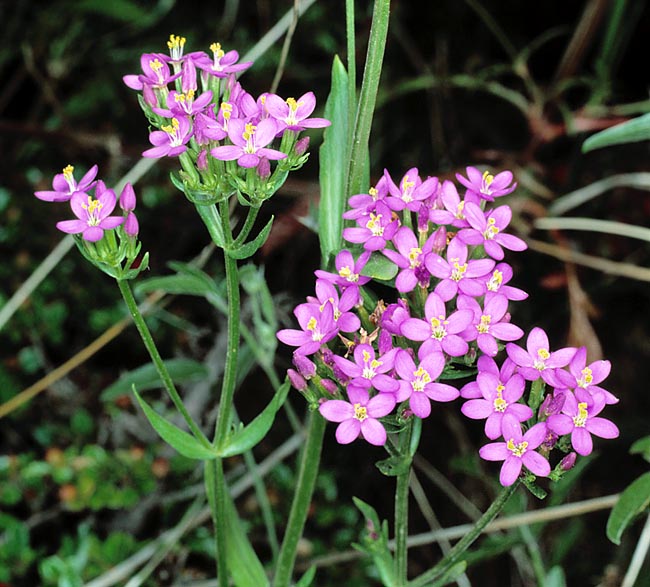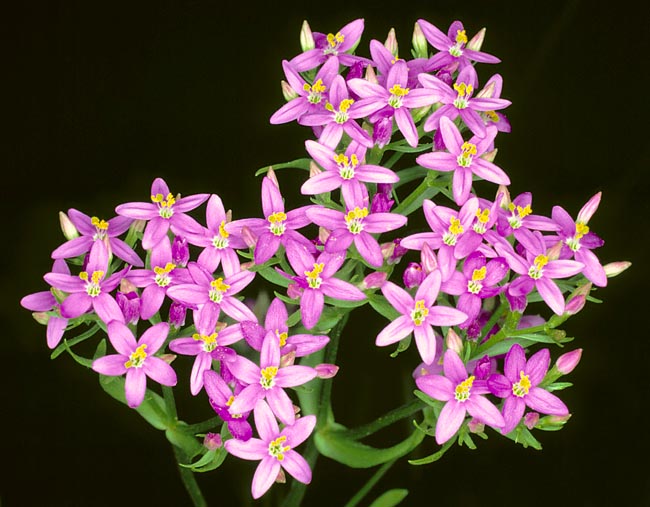Family : Gentianaceae

Text © Eugenio Zanotti

English translation by Mario Beltramini

Centaurium erythraea is a paleo-temperate 10-30 cm herbaceous plant © Giuseppe Mazza
The name of the genus comes from the mythological centaur Chiron, Achilles’ preceptor, famous in the art of treating many ailments; the species epithet comes from the Greek “erythros” = red, due to the red colour of its flowers.
Common names: Centauro maggiore, Erba-china, Chirònia, Biondella (Italian); Common centaury, Bitter herb, Small centaury (English); Petite céntaurée rouge, Erythrée petite-centaurée, Herbe à la fièvre (French); Centaurea umbelada, Centaurea menor (Spanish); Echtes Tausendgüldenkraut, Fieberkraut (German).
It is a herbaceous glabrous plant with biennial or annual cycle, 10-30 (50) cm tall, with erect stem, slender, angular due to protruding sub-winged nervations, simple below, with ascending branches on top, furnished with tapering root. Basal leaves in persistent rosette, obovate-obtuse attenuated at the base, opposite cauline, sessile, ovate or lanceolate, acute, decreasing, entire.
The flowers, up to 1 cm broad with pink petals, are more or less purplish, ovate, with obtuse apex, star-expanded and merged at the base in a tube and united in terminal foliar corymbs. Calyx of 4-5 mm. The flowering goes on from May to September. The fruits are 2-10 mm cylindrical capsules opening when ripe for two valves freeing very tiny brownish seeds with finely netted surface. The whole plant has a decidedly bitter taste.
Of this small but elegant and polymorphous plant several subspecies and numerous varieties have been described. After Prof. Pignatti (Flora d’Italia:1982) the tetraploid subspecies have been able to expand amply in all temperate and temperate-cold Eurasia and, more recently, they have been introduced by the man also in North America.
The common centaury grows in even much differing habitats such as muds and wet sands (also brackish), shady paths, grassy places, stony pastures, dry meadows, moors, thickets and garrigues, from the plain up to 1500 metres of altitude.
It is an herb known and utilized since the old times, appreciated by Greeks and by the Gauls, and still used in the popular traditions of many locations. In Italian, it is also known as “biondella” (=little blonde) due to the property of its decoction to bleach hairs and freckles.

The pink or purplish terminal corymbs have medicinal virtues. Cultivated also for liqueurs industry © G. Mazza
They have repeatedly proven its well known bitter-tonic, appetizing, eupeptic, stimulant of gastric secretion, activator of the digestive processes, antipyretic properties which are employed in the inappetence and in the difficult digestions especially under form of infusion and of tincture. For external use, it is effective as detergent and as cicatrizant. It is inadvisable for the subjects suffering from gastric hyperacidity (hyperchlorhydria), gastritis and ulcer. In the popular medicine it was for long time used like the quinine for fighting malaria fevers. The infusion of centaury is prepared with two grams of dried plant in 150 ml of boiling water for 15 minutes, to drink lukewarm ½ hour before the meals.
Appetizing infusion against anorexia
A spoonful of flower tops in a pot of water: when it begins boiling, remove from the heat and let infuse for ten-twelve minutes. To drink half a pot half an hour before the two main meals, sweetening to taste.
Appetizing, tonic and digestive medicinal wine
A handful of flower tops in one litre of sweet white liqueur wine (for instance, Passito di Pantelleria): to let macerate for one week and shake from time to time; to filter and to consume a shot before the meals as appetizer-tonic or after the meals as digestive.
Synonyms
Centaurium minus Weinm. (1764); Centaurium umbellatum Gilib. (1781); Centaurium minus Moench (1794); Erythraea centaurium (L.) Pers. (1805).
→ To appreciate the biodiversity within the GENTIANACEAE family please click here.
